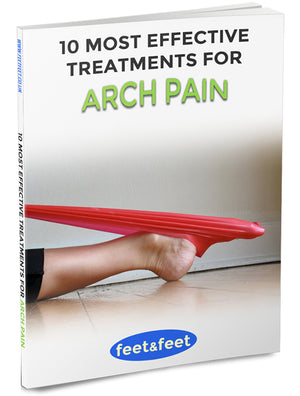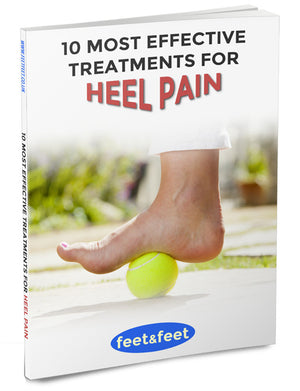What is Flat Feet or Fallen Arches?

Flat feet (also known as fallen arches) are a postural deformity. Individuals who have this condition will have no arch on the bottom of their foot; the entire sole of the foot will usually come in complete or almost-complete contact with the ground whenever the individual stands.
The condition is actually surprisingly common, and it’s estimated that somewhere between 20% to 30% of the population have an undeveloped arch in either one or both of their feet. Flat feet typically affect both children and adults; it may even develop in individuals who do a lot of sports.
The arch is a functional structure between the foot and lower leg; it plays an important role in reducing the forces incurred during weight bearing on the foot before the forces reach the long bones in the leg and thigh.
Being flat footed may not cause immediate issues; in fact some people don’t even notice they have the condition at all in their lifetime. However this disorder can seriously disrupt your body’s alignment and cause weakened posture or discomfort starting from your hips and into your lower back.
This article will help you understand what the condition flat feet is, the causes and symptoms of flat feet, and what treatment options are available to help fix flat feet in order to relieve associated aches and pains.
What Causes Flat Feet or Fallen Arches?
Flat feet can cause unnecessary pain and discomfort; there are many possible causes of the condition such as:
- An abnormality present from birth, some individuals can have problems with the development of the bones in their feet before birth.
- An inherited tendency to have flat feet, this condition can be a genetic abnormality
- Previous research suggests that some individuals who have an increased activity of proteolytic enzymes in their body are more likely to develop flat feet. This is because these enzymes can break down components in tendons which eventually cause the foot arch to fall. There is still more research to be carried out to understand what causes flat feet.
- Stretched or torn tendons which can cause pain in the inner ankle causing the individual to gradually lose the inner arch of their foot.
- Damaged or inflammation of the posterior tibial tendon (PTT). This tendon connects the lower leg, along the ankle and to the middle of the foot’s arch.
- Damage or injury to the connective tissues as a result of aging, overuse or broken and dislocated bones.
- Medical conditions which affect the joints such as arthritis
- Medical conditions which affect the nerves such as cerebral palsy
- Medical conditions which affect connective tissues such as joint hypermobility syndrome
There are also other conditions which can increase your risk of developing flat feet, some risk factors are:
- Diabetes – High blood sugar levels can affect circulation and damage sensory and motor nerves in the body. Any nerve damage is known as neuropathy; damage to the nerves which supply the foot muscles with information about movement can cause your feet shape to alter.
- Pregnancy – Both additional body weight and a fluctuation in hormones can soften supportive ligaments and lead to flat feet and even overpronation.
- Obesity – Excessive body weight can force the arch of the foot to flatten, this means that the ligaments and tendons which usually connect the bones and joints have to stretch and the arch collapses. Obesity is thought to be the leading factor in what causes flat feet in adults.
- Aging – Throughout life aging can lead to a decrease in the strength of muscles, tendons and ligaments which can contribute to the development of flat feet.

Symptoms of Flat Feet or Fallen Arches
Flat feet may not cause any pain or related problems for some people who are asymptomatic, which simply means that no further treatment or medical intervention is required. However symptoms for those who are affected can include:
- Feet feeling painful in the areas of the arches and heels, or tire easily even when wearing shoes which are supportive and well fitted.
- The sole of the foot becoming swollen
- The arches of the foot rolling inwards too much (a sign of overpronation), which leads to injuries and shoes appearing to wear out quicker than you would expect.
- Simple foot movements such as standing on your tip-toes feel difficult.
- Feelings of numbness, weakness or stiffness in your feet.
- Spreading pain starting from the feet, ankles, lower legs, knees, hips or lower back. This is because your feet support your entire body, and when the ligaments and tendons in your feet weaken they can cause intense pain throughout your body. This also contributes to an improper posture which can lead to aches and problems in the head and neck over time.
A foot roller can help strengthen the arch of your foot.
How to Fix Flat Feet or Fallen Arches
Treatment for flat feet depends on the severity of the condition and the cause of the problem. If you show no symptoms of flat feet then no further medical intervention will be required.
It’s best to consult a doctor who can examine the arches of your feet and while keeping in mind your current condition, can devise a customised treatment plan for you.
Your doctor may suggest one or more of the following treatments for how to fix flat feet:
- Elevating the feet and applying ice in order to relieve pain and reduce any swelling. Simple rest is also recommended.
- Pain relief medications, most likely non-steroidal anti-inflammatories
- Pain relief injected medications to reduce any inflammation, most likely corticosteroids
- Stretching exercises for the feet or professional physiotherapy, not only can these exercises provide instant relief for flat-footed pain but they can also strengthen the muscles in the foot to stop overpronation of the feet.
- Orthotic devices or customised arch supports, modification for your shoes, braces or casts. These devices offer more support to the foot and can prevent pain from occurring. They can also stop the condition from worsening by preventing the feet from rolling inwards towards each other.
- Weight loss program if you are overweight or obese. By reducing weight the pressure on the feet is significantly reduced, meaning less pain.
These measures won’t actually change the shape of your foot; however they will relieve some of the problems which are associated with flat feet. If none of these flat feet treatments work for you, then surgery may also be an option.
Surgery is usually only considered if there is an underlying problem which can be corrected via an operation, such as an abnormal bone development in the foot.
For example, bones which are shaped abnormally or joined together can be straightened out and separated through surgery. Otherwise, if the flat feet are caused by an issue with the connective tissues, then they can be treated by lengthening or possibly even repairing the affected connective tissues.
If you want to learn more about what flat feet is, or flat feet treatment options, speak to your doctor or podiatrist for a more detailed explanation.






Leave a comment